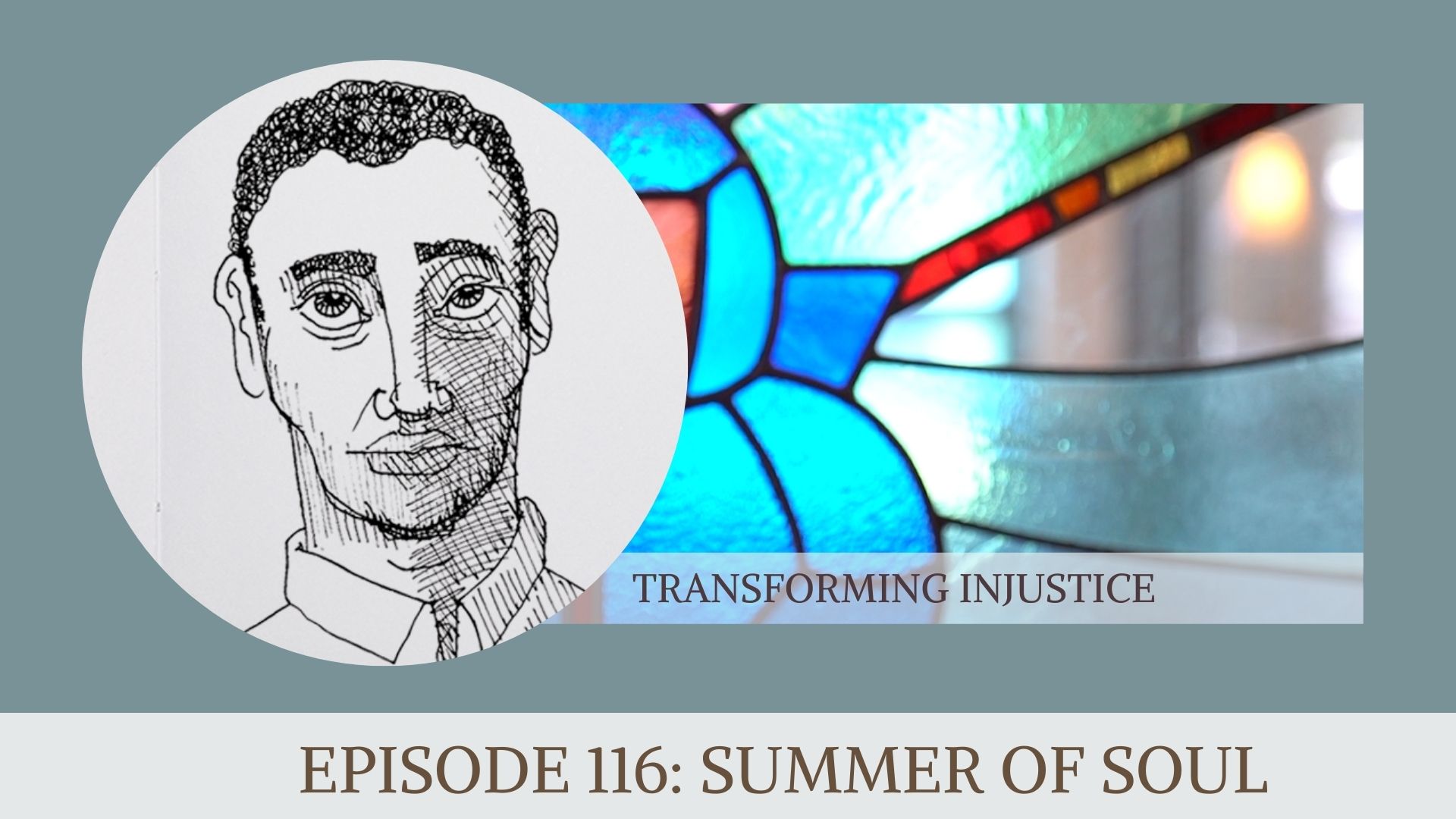On this long weekend, what is on your mind? How to spend your extra day? Barbeque, burgers or chicken? Or maybe you are thinking about the relationship between citizenship and discipleship? No? Well, that’s where my mind is. On injustices. And how transformations are possible.
If the last 16 months of pandemic life showed us nothing else, it showed us we cannot ignore injustices around us. And whether we are responding as citizens of the United States, immigrants to this country, people of faith, or religious leaders, injustice commands our attention. Whatever your starting point, the call and response of injustice and transformation is here.
Transforming Injustice
In this week’s video, I tell stories from the life of an African Methodist Episcopal minister, Pastor James.* He shared with us his experiences of bussing, playing sports, and the traumas of growing up Black in the South.
In a stunning and inspiring turn, James says “what set me back as a child, cast me forward as an adult.” So much in our collective life still feels like it sets us back. We are not where we need to be with justice or equity. People still suffer unjustly in this country for no other cause than their gender, sexual orientation, or racialized identity. We need more understanding, still. And we need more courage to do the right things, still. God’s call to participate in the transformation of injustice is literally everywhere around us.
This weekend I heard that call in the Summer of Soul (… Or, When the Revolution Could Not Be Televised) a new documentary produced by Questlove. It is a story that has not been told for 50 years, a story of six weeks of concerts in Harlem in 1969. Everyone has heard of Woodstock but very few have heard of the Harlem Cultural Festival happening less than 100 miles away in the same summer. My ten reasons to see it are below.
Today, I invite you to ask yourself:
How am I participating in the transformation of injustices in my ministry?
The ways you see and experience injustice will be shaped by your own social location and that of your congregation or ministry setting. Where you are and who you are and who you serve will also shape the way you answer the question. And the call.
More on Transforming Injustice: video | blog | podcast
10 reasons you need to go see the Summer of Soul
1) Untold Stories
The stories around the Harlem Cultural Festival of 1969 remained hidden and untold for 50 years. Of course the people who were there remember it. And it is so fun to see some of them interviewed about their experiences as children and teenagers at the event. The concert series was part of a turning point in music, civil rights and Black identity. It made an impact and the rest of the world needs to know about it. You need to know about it.
2) The Music
Stevie Wonder on drums. That’s right drums. Gospel choirs. The Fifth Dimension. Jazz. African and Caribbean drumming. The blues of B.B. King. It’s great and it was professionally filmed so the sound is good and it WAS the music of 1969. Not just what you could’ve heard at Woodstock. I mean baby Gladys Knight and the baby Pips. They weren’t babies, but they were so young and new and they are fantastic! Mahalia Jackson and Mavis Staples on the same stage singing Precious Lord, Take My Hand. It just doesn’t get better.
Get ready for “the best concert movie of the 21st century.” (Rolling Stone)#SummerOfSoulMovie, A Questlove Jawn. Now Playing in Theaters and on @Hulu.
— Summer of Soul (@summerofsoul) July 2, 2021
3) Documentary Debut
It may be Questlove’s debut documentary, but what a powerful start. For me, the work of interviewing attendees, journalists, the performing artists, and more makes the piece so strong. The interweaving with other footage from 50 years ago, and tying together the major issues of the late 60s is all exceedingly well done.
4) The Moonshot
You need to understand the moonshot and new way. I grew up on the same narrative many of you did. What an amazing and powerful moment but human beings got beyond ourselves and the planet earth to land a craft on the moon. I’ve long thought it awkward and selfish that an American flag was planted there. Now I know the selfishness ran much deeper. It can both be true that going to the moon was an amazing feat of science and engineering, and also held up against the fact that people were starving in New York City and in towns and cities across the country. We’ll suffice it to say, the moon landing has more than one meaning. And really that’s the whole point of this documentary. Everything in life has more than one meaning and more than one narrative to tell what happened. Learn a new narrative!
5) A Church Story
The church and its music and values are everywhere on the stage of the Harlem Music festival of 1969. Six weeks of artists and musicians who were raised in the church. Most had been singing in church since they were children. The Black Church was a haven for folks suffering massive, life-threatening injustice. It was also a seedbed for change. Music was just one of the pathways. See it on full display on the stage at the Harlem Cultural Festival. (This reminds me to say that I’ll be looking hard for the Aretha Franklin movie next month and you should too.)
6) Civil Rights Story
This series of concerts was a continuation of the civil rights movement and a memorial to Martin Luther King, Bobby Kennedy, Malcolm X and JFK. Questlove interviews both Al Sharpton and Jesse Jackson. A young Jackson was centerstage helping to memorialize losses of the civil rights movement leaders. He was also calling on people to be part of Operation Bread Basket. Don’t know what that is? Another good reason to go see the movie!
7) Embodiments of Change
Change was already underway. And new expressions of that change were everywhere. Let’s consider for example Sly and the family stone. Here’s the track you probably know best. And this clip is from that stage in Harlem in 1969.
With his band he was making a statement about what a family is and what kind of transformations are needed. Women (his sisters) played instruments and sang powerful vocals. Band members were both Black and white, nearly unheard of at the time.
8) Nina Simone
That’s enough said. But seriously her power her presence and that song backlash! It was new to me and now a day later, I’ve listen to it through and through.
Learn more about the evolution and struggles of Nina Simone. Her mother was a Methodist preacher. She attended Julliard to hone her piano skills. After some struggle and rejections, she became a singer and performer. Her affiliations with the civil rights movement and its leaders gave her big voice and truth telling more and more room to be heard publicly.
9) The Crowd
High-quality cameras and film captured the events of the concert series. And although it sat for decades untouched, it opens up now like a goldmine of images. The documentary captures amazing offstage moments: a beautiful sea of faces, children dancing, people up on the rocks getting a view of the stage. People dressed up and dressed casual. Giving knowing looks, singing along, and immersed in joy and wonder. As one of the commentators in the documentary puts it: just so many beautiful Black people.
10) Transforming Injustice
It takes many pathways to transform racialized injustice or injustice of any kind. How many pathways are on display in this documentary? The Black Panthers or the security for the concert. Why? Because the police department wouldn’t send officers to provide security for the staff the performers and the attendees which or anywhere from 50 to 100 thousand every weekend. Eventually the police got on board but the Black Panthers made it possible to sign the various artists. The city of New York also got on board and we learn about a white mayor, John Lindsay who knew how to interact without defensiveness in the Black and Brown communities of his city. Harlem was not home solely to African Americans in the late 1960s large numbers of Puerto Rican expatriates and other Spanish speakers and immigrants lived in that part of the city as well.
Harlem was a place of organizing for protest and also a cultural center for arts, music and dance. It was home to influential Black churches and the Nation of Islam, and traditional African and Afro-Carribean influences ran through all of it.
In the Summer of Soul, many streams converge into a river of stunning inspiration, joy and empowerment. The revolution may not have been televised in 1969, but you can be a witness in 2021. I hope you will let it transform you.
*All LPI study participant names are pseudonyms. And stories are shared with permission. To read James’ story get your copy of Pastoral Imagination today.




